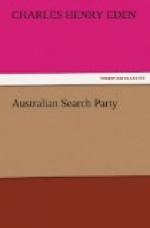“Bird been make it that fellow; plenty d—d thief that fellow, steal like it pipe, like it anything.”
It then flashed across me that I had fallen in with the “run” of the bower-bird, of which I had so often heard, and had so often sought for without success.
The satin bower-bird (’Ptilonorhynchus holosericus’) belongs to the family of starlings, and though tolerably common in New South Wales, is but a rare visitor to the hotter climate of Northern Queensland. The plumage of the adult male is of a glossy satin-like purple, appearing almost black, whilst the females and the young are all of an olive-greenish colour. The peculiarity for which this bird is generally known, is its habit of constructing a sort of arbour of dry twigs, to act as a playground. These bowers are usually made in some secluded place in the bush — not infrequently under the shady boughs of a large tree — and vary considerably in size, according to the number of birds resorting to them, for they seem to be joint-stock affairs, and are not limited to one pair. The bower itself is somewhat difficult to describe, and a better idea can be formed from the engraving, or by visiting the British Museum, where several are shown, than I can ever hope to set before the reader in words. A number of sticks, most artistically woven together, form the base, from the centre of which the walls of the structure arise. These walls are made of lighter twigs, and considerable pains must be taken in their selection, for they all have an inward curve, which in some “runs” cause the sides almost to meet at the top. The degree of forethought that these self-taught architects possess is strikingly exemplified in the fact that, whilst building the walls, any forks or inequalities are turned ‘outwards’, so as to offer no impediment to their free passage when skylarking (if it is not an Irishism, using such an expression with regard to a starling) and chasing each other through and through the bower, to which innocent recreations, according to the testimony of Messrs. Cato and Ferdinand, they devote the major part of their time. Their love of finery and gaudy colours is also most remarkable. Interwoven amongst the twigs of which the bower is composed, and scattered about the ground in its vicinity, are found bleached bones, broken oyster, snail, and cowrie shells, and not unfrequently, in the more civilised districts, pieces of coloured rag, and fragments of ribbon pilfered from some neighbouring station, for, in search of attractive objects to decorate his playground, the bower-bird entirely ignores the eighth commandment, and, I fear, justifies the somewhat strong expression of “d—d thief” which Ferdinand bestowed on him. Indeed, so well are his filching propensities known to the natives, that they make a practice of searching the runs whenever any small article of value is missing, and often succeed in recovering the lost object.




